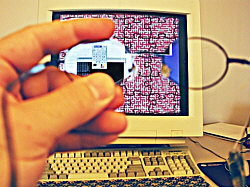If you work on anything where you really need to protect what is displayed from inadvertant viewing, perhaps you need one of Mitsubishi’s new privacy enhanced computer displays. The short explanation of how the display works is that it rapidly draws the intended image along with the inverse of that image. You wear special glasses to screen out the inverse image, but anyone without the glasses synced to your display only sees grey static due to the blending of the two images.

The privacy-enhanced computer display uses a ferroelectric shutter glasses and a special device driver to produce a computer display which can be read only by the desired recipient, and not by an onlooker. The display alternately displays the desired information in one field, then the inverse image of the desired information in the next field, at up to 120 Hz refresh. The ferroelectric shutter glasses allow only the desired information to be viewed, while the inverse image causes unauthorized viewers to perceive only a flickering gray image, caused by the persistence of vision in the human visual system (as illustrated here). It is also possible to use the system to “underlay” a private message on a public display system.
. . .
Technical Discussion: The system consists of two display sources (the public display image Pij and the secret display image Sij) a special device driver, a fast-refreshing CRT, and a set of synchronized ferroelectric shutter glasses. If there is no desired public display, the RGB value (255, 255, 255) can be used. The special device driver alternately displays images of (Pij – Sij ) and ( Sij ). The human eye’s persistence of vision blurs the two images into (Pij – Sij + Sij ) / 2, which reduces to Pij / 2, which is the public image, without any secret image being visible. To someone wearing the synchronized glasses, only the Sij image is seen.
It doesn’t even appear this is new technology – the web site shows a last modified date in 2001. Still, if you haven’t seen this before, I guess it’s news. And even 5 years later, it’s cool technology. The site mentions possibly upgrading to a wireless glasses system, but for now, the glasses to make this work are wired to the computer powering the display
[tags]Privacy enhanced computer display[/tags]